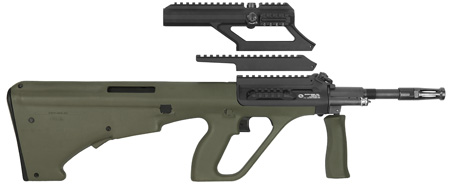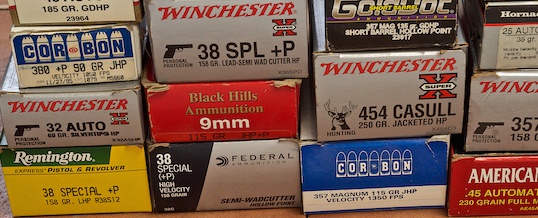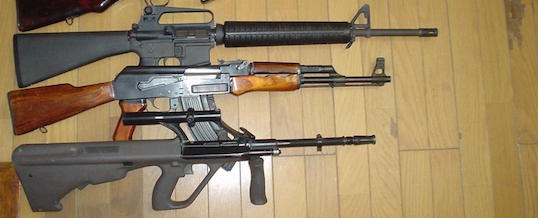
The Bullpup Rifle Experiment, Part 1: why would I do such a thing?
As you may know, I’m a proponent of the rifle as a defensive tool — particularly for what I refer to as “perimeter defense”, which are threats at distances beyond which we think of the pistol as a more suitable tool, and for defense of a fortified or ensconced position (like being barricaded in your safe room.) The rifle’s greater power, greater precision, and corresponding ability to deliver both at extended distances makes it a formidable tool in the correct circumstances.
Through the years I’ve possessed a number of rifles for defensive purposes, and have actually used them on more than one occasion in that role (mostly against four-legged predators and rabid animals, though on one occasion against a pair of attackers who posed an immediate lethal threat; in that case, I fired no shots and the situation was resolved without injury.) I’ve used lever-action carbines, the AR-15 in a couple of configurations, and the FN-FAL (the latter being the rifle at hand in the incident I mentioned.)
I’ve had a lot of trigger time and put multiple tens of thousands of rounds downrange with each of those designs, as well as training, teaching, and the odd shooting match here and there. I think it’s fair to sat that I’m quite used to those three rifle types, but that doesn’t mean that I don’t have some experience with others as well — with significant trigger time on the M1 Garand, M1 Carbine, AK-47 pattern, Ruger Mini-14, AR patterns in .308, and various bolt actions (regular as well as a couple of Scout Rifle versions.) I have yet to find a truly “universal” rifle, though a short bolt action with a box magazine comes surprisingly close.
There is one class of rifle, however, with which I’ve had little to no experience: the bullpup. This isn’t all that surprising; until a few years ago, bullpup rifles were downright rare in this country despite being in fairly common military service outside of the U.S. The result of that rarity is a lack of relevant operational knowledge of their strengths and limitations, even though lots of people will gladly tell you everything about them having never actually shot one!
[callout1]I wanted to find out for myself what the bullpup rifle was all about.[/callout1]
This isn’t a new phenomenon; it was the case with the AK-pattern rifles a decade or so back. Those of you who are younger than I am may find this hard to believe, but at one time in the not too distant past AK-type rifles were extremely rare in the U.S. None were made here, none were able to be imported, and there were no such things as parts kits. Before the old SKS started to be imported in large quantities during the 1980s, their 7.62×39 ammunition was rare and no U.S. companies loaded it. Even after the SKS became common, the AK-47 was still a rarity on the firing line.
After the fall of the Soviet Union in the early 1990s, AK rifles started being imported in numbers. Soon they were showing up in rifle and “tactical” classes, but the problem was that very few (emphasis on the word “few”) instructors then in the business really knew anything about the AK pattern. They didn’t know how to deal with the “odd’ magazine release nor the relatively non-ergonomic safety lever. The result is that a lot of instructors either a) tried with varying degrees of success to shoehorn the AK rifle into the techniques they were teaching for the ubiquitous AR-15, or b) simply threw their hands up and declared the AK “not suitable for defensive use”. A few actually banned the “commie rifle” from their classes!
Luckily a few intrepid instructors decided to buy their own AK-47s and figure out what the best, most efficient handling techniques were. They were able to work around the AK’s perceived limitations and develop solid doctrine for the use of the guns. Before long, it seemed everyone was teaching people how to use the AK properly. The naysayers? They were either assimilated or fell by the wayside.
In many ways the situation with the bullpup rifle today is the same. I’m actually a little appalled at the number of “instructors” I’ve encountered who speak negatively of the bullpup design yet have no significant experience with them. Their knowledge, like that of the AK-47 naysayers many years before them, is mostly second hand — and often wrong.
I wanted to find out for myself what the bullpup rifle was all about. I wanted to see if the “common knowledge” about their faults was true; if it was, I wanted to find out if there were training or doctrine changes that would address the issues. If it wasn’t, I wanted to be able to speak from a position of authority as to why it wasn’t.
To do that, though, I needed a bullpup to test — and not like the gun magazine “I took it to the range once or twice and shot a few rounds through it” kind of “test”. I needed one for an extended time period, one which likely wouldn’t be going back to the manufacturer in salable condition. It was going to get shot and generally treated like the tool it’s supposed to be.
I had several choices, but my first call went to Steyr Arms. Why? Well, first because the Steyr AUG is the unarguable progenitor of all the bullpups which we have today. It was the first successful bullpup rifle, both militarily and commercially, and really set the pattern for most of what would follow. It’s also the oldest design (having been adopted in the mid-1970s) and has the longest track record. I figured it was probably a good bet that any bugs had long since been worked out of the design.
The other reason I called Steyr was because I’ve carried one of their S9 pistols for more than a decade, and I generally like their designs and especially the quality of construction. If their pistols are as good as I’d found, I reasoned, their rifles probably would be as well.
Luckily they agreed with this crazy plan of mine to learn everything I could about bullpup rifles and then teach others what I’d learned, and kindly lent me a new AUG A3 M1 model with integrated optic — along with a bunch of magazines. I promptly set about burning ammunition!
One problem surfaced immediately: Austrians apparently are taller than I am and have better eyesight than I do. The standard military-issued optic proved to sit just a little too high and just a little too far forward for my short little neck, and I couldn’t get a solid cheek weld with the scope in that position. What’s more, the scope doesn’t have any mechanism for focusing. If you have 20/20 uncorrected vision that’s fine, but when you wear glasses like I do it simply means that the scope is continuously fuzzy. It’s not a lot, and was still usable if I really forced myself to ignore it, but it was pretty clear (pardon the pun) that I was going to need a different optic if I was going to make this test fair.
When I was at SHOT Show 2015 I’d run across a booth for Meopta Sports Optics. Most people there probably didn’t recognize that name, but I sure did: they’re a Czech manufacturer of optics that I remember from my days in the photographic industry, circa 1982. Back then they had a reputation for solid, quality products and I was not surprised to find that their current product line was of superb design and construction. Their binoculars (a surprisingly difficult product to make well) were really quite good, and I left their booth impressed with how my “old friends” were doing!
When I decided I’d need a replacement optic, I told Meopta about my little experiment and asked them if they’d like to help out by sending me one of their M-RAD red dot sights with a 3 MOA reticle (again, with the warning that I was really going to use the thing.) They agreed and even suggested that I might want to look at one of their conventional optics that had proven very popular with the Eastern European contingent of coalition forces in the Middle East: their 1-4×22 ZD Tactical scope. They sent both out and I got a chance to try both. I’ll have more to say about those in a later article.
So, Meopta-optic-equipped Steyr AUG A3 M1 in hand, I set out to discover everything I could about the bullpup rifle and along the way hopefully answer a question: does this thing really have a use in the world of self or home defense? Stay tuned; the adventure is just starting!
– Grant Cunningham
P.S.: For such a simple name, Steyr seems to get misspelled a lot! So far I’ve seen “Steyer AUG” (which is the most common misspelling), “Styer AUG” and “Stier AUG”. I even once saw a review from a fairly well-known gun writer who never once spelled it correctly (and I have the screenshots to prove it!)
Oh, and the Austrians — who are a fun-loving group of firearms enthusiasts — tell me the model is properly pronounced “ay-you-gee”, not “awg”. Now you know!
- Posted by Grant Cunningham
- On September 28, 2015



